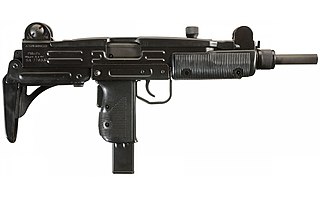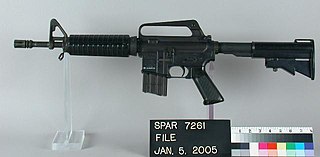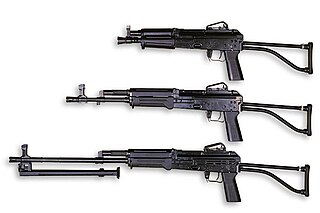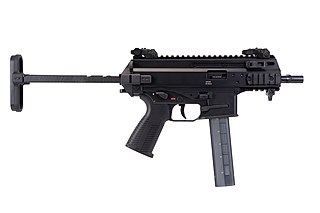
A machine pistol is an autoloading pistol capable of fully automatic fire, including stockless handgun-style submachine guns.

A submachine gun (SMG) is a magazine-fed automatic carbine designed to fire handgun cartridges. The term "submachine gun" was coined by John T. Thompson, the inventor of the Thompson submachine gun, to describe its design concept as an automatic firearm with notably less firepower than a machine gun. As a machine gun must fire rifle cartridges to be classified as such, submachine guns are not considered machine guns.

The IMI Galil is a family of Israeli-made automatic rifles chambered for the 5.56×45mm NATO and 7.62×51mm NATO cartridges. Originally designed by Yisrael Galili and Yakov Lior in the late 1960s, the Galil was first produced by the state-owned Israel Military Industries and is now exported by the privatized Israel Weapon Industries.

The Uzi is a family of Israeli open-bolt, blowback-operated submachine guns and machine pistols first designed by Major Uziel "Uzi" Gal in the late 1940s, shortly after the establishment of the State of Israel. It is one of the first weapons to incorporate a telescoping bolt design, which allows the magazine to be housed in the pistol grip for a shorter weapon.

The STEN is a British submachine gun chambered in 9×19mm which was used extensively by British and Commonwealth forces throughout World War II and during the Korean War. The Sten paired a simple design with a low production cost, facilitating mass production to meet the demand for submachine guns.

The M4 carbine is a 5.56×45mm NATO, select-fire, gas-operated, magazine-fed carbine developed in the United States during the 1980s. It is a shortened version of the M16A2 assault rifle.

The Military Armament Corporation Model 10, officially abbreviated as "M10" or "M-10", and more commonly known as the MAC-10, is a compact, blowback operated machine pistol/submachine gun that was developed by Gordon Ingram in 1964. It is chambered in either .45 ACP or 9mm. A two-stage suppressor by Sionics was designed for the MAC-10, which not only abates the noise created but makes it easier to control on full automatic.

Knight's Armament Company (KAC) is an American firearms and firearms parts manufacturer, best known for producing the Rail Interface System (RIS) and the Rail Adapter System (RAS) grips for firearms use. They currently produce a variety of firearms, specifically AR-15 rifles.

The PM-84 Glauberyt is a Polish submachine gun. It is a personal weapon intended for combat and self-defence at ranges up to 150 m with single shot or fully automatic fire mode. It features a compact design, minimum overall dimensions, small weight, very good accuracy, and fire stability. It is designed for heavy weapons platoons personnel and reconnaissance detachments, special anti-terrorist and police troops.

The Colt Automatic Rifle-15 or CAR-15 is a family of M16 rifle–based firearms marketed by Colt in the 1960s and early 1970s. However, the term "CAR-15" is most commonly associated with the Colt Commando ; these select-fire carbines have ultrashort 10.5-inch (270 mm) and 11.5-inch (290 mm) barrels with over-sized flash suppressors.

A firearm is said to fire from an open bolt or open breech if, when ready to fire, the bolt and working parts are held to the rear of the receiver, with no round in the chamber. When the trigger is actuated, the bolt travels forward, feeds a cartridge from the magazine or belt into the chamber, and fires that cartridge in the same movement. Like any other self-loading design, the action is cycled by the energy released from the propellant, which sends the bolt back to the rear, compressing the mainspring in readiness for firing the next round. In an open-bolt gun firing semi-automatically, the bolt is caught and held at this point by the sear after each shot; and in automatic open-bolt fire, it's caught and held in this manner whenever the trigger is released. In contrast to this, in closed-bolt guns, the trigger and sear do not affect the movement of the bolt directly.

The CZ Model 23/25 was perhaps the best known of a series of Czechoslovak designed submachine guns introduced in 1948. There were four generally very similar submachine guns in this series: the Sa 23, Sa 24, Sa 25, and Sa 26. The primary designer was Jaroslav Holeček, chief engineer of the Česká zbrojovka Uherský Brod arms factory.

The Moschetto Automatico Revelli-Beretta Mod. 1915 was a self-loading carbine that entered service in 1918 with the Italian Armed Forces. Designed as a semi-automatic carbine, the weapon came with an overhead inserted magazine, an unconventional design based on the simplicity of allowing a spent round to be replaced using assistance from gravity. The gun was made from half of a Villar-Perosa aircraft submachine gun.
The MAB 38, Modello 38, or Model 38 and its variants were a series of official submachine guns of the Royal Italian Army introduced in 1938 and used during World War II. The Beretta Modello 38 was first issued to Italian police units stationed in Africa. The Italian army were impressed and decided to adopt a version to be used by elite troops and military police, but requested a modified variant which had no bayonet and a different recoil compensator. The MAB 38 was widely used and saw service on all fronts. The guns were also used by the German, Romanian, and Argentine armies of the time.

The FAMAE SAF is a submachine gun produced and manufactured by FAMAE since 1993.

The KRISS Vector is a series of weapons based upon the parent submachine gun design developed by the American company KRISS USA, formerly Transformational Defense Industries (TDI).

The ČZ 2000 is a prototype 5.56 mm caliber Czech weapon system, consisting of a standard rifle, carbine and light machine gun. The system was developed in 1991 after adapting the LADA firearm prototype J. Denel from the Brno-based Prototypa-ZM company is the chief designer for both systems. The ČZ 2000 was to be produced by Česká zbrojovka of Uherský Brod. It was planned to be the new service weapon of the Czech Army, replacing: the 7.62 mm vz. 58 assault rifle, 7.65 mm vz. 61 Škorpion submachine gun and 7.62 mm vz. 59 machine gun. As of 2007, the project has been discontinued.
The Demro TAC-1 is a semi-automatic carbine chambered in either .45 ACP or 9×19mm Parabellum. The TAC-1 is the reintroduction of the Fox Carbine to the law enforcement market after a fallout between Gerard J. Fox, the inventor, and Dean Machine Inc. of Manchester, CT. Although it is visually similar to the Thompson submachine gun the operation and design is quite different. The design is a closer cousin to the Soviet PPSh-41.

The Adaptive Combat Rifle (ACR) is a modular assault rifle formerly designed by Magpul Industries of Austin, Texas, and known initially as the Masada.

The B&T APC is a submachine gun produced and manufactured by B&T of Switzerland. Announced in 2011, the standard series uses standard 9×19mm (APC9), .40 S&W (APC40), 10mm Auto (APC10), and .45 ACP (APC45) ammunition.


















